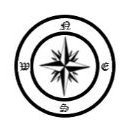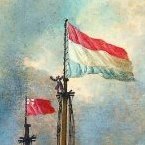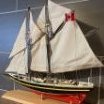Supplies of the Ship Modeler's Handbook are running out. Get your copy NOW before they are gone! Click on photo to order.
×
-
Posts
10,046 -
Joined
-
Last visited
Reputation Activity
-
 ccoyle got a reaction from flying_dutchman2 in Pt. IV: Tools & Other Supplies
ccoyle got a reaction from flying_dutchman2 in Pt. IV: Tools & Other Supplies
UPDATED JULY 2024
Only a few tools are needed to get started in card modeling. At the very least, you need a cutting tool and some glue. Everything else is optional.
Here are some basic tools:
You'll need a self-healing cutting mat, available from most office supply or crafts stores. Next, you need something to cut with. Most card modelers do not use scissors. A garden-variety craft knife does the job nicely and with more precision. Some card modelers use scalpels. Get a good supply of #11 blades -- card can be surprisingly hard on them. A steel rule is a must, not just for measuring, but more importantly for cutting straight lines.
Glue is, of course, essential. A variety of glues will work. Each has its own merits and drawbacks. PVA glue, either white (e.g., Elmer's) or yellow (wood glue) are good general purpose glues. Lately I have grown fond of Evergreen's Canopy Glue, which is a PVA-type glue that grabs quickly and dries fast. Bear in mind that PVA glues are water-based, and card can absorb the glue and deform. PVA is therefore not a good choice for gluing large surfaces together.
Cyanoacrylate glue, or CA ('Super Glue'), has its uses. Fast-cure CA can be wicked into card stock to stiffen it. Medium-cure CA is useful for gluing parts made of different media together, as well as for paper-to-paper bonds.
Contact cement (not to be confused with rubber cement) is a non-water-based glue and thus good for gluing large surfaces together. Contact cement sets rapidly, so repositioning of parts once they come in contact with each other is not possible.
Now, on to some optional items.
From left to right:
blackened, annealed wire - an assortment of diameters is useful for making gun barrels, railings, etc. styrene rod - card can be rolled into tubes, but styrene is often a better choice assorted paint brushes - for painting and as aids for rolling tubes tweezers paint, marking pens, or other media for coloring cut edges (more on this later) calipers - for measuring card stock thickness, especially when laminating sheets together hobby pliers (not pictured) - for cutting and forming wire (end nippers, needle nose, round nose)
Some other useful items to have are thin, flexible, clear acetate sheets (for glazing windows), matte clear spray varnish (for prepping parts sheets), and 3M spray adhesive (for laminating card and/or paper sheets together). 3M costs more than other brands, but take my advice, it's worth the money. Cheaper brands don't coat as evenly and produce clumpier spray patterns. Trust me -- I learned this the hard way.
I'll add other items if I remember them. Now, go get your supplies and let's build a model!
Back to Part III: Shopping for Card Models On to Part V: Building V108 - The Hull
-
 ccoyle got a reaction from BenD in Pt. III: Shopping for Card Models
ccoyle got a reaction from BenD in Pt. III: Shopping for Card Models
UPDATED 7/2024
This tutorial is based on a free kit. But supposing you wished to buy a paper model kit, where could you get one?
Let's start with The Big Question on everyone's mind: Who makes the 'best' kits? The first thing you must do is separate in your mind the concepts of best kit and best kit designer. They are not the same thing. Some designers publish their own models, but many don't. Their kits are printed by various publishing houses -- often more than one. This fact makes it difficult to generalize about this publisher versus that publisher. Your favorite designer might have his designs printed by multiple publishers. The lesson here is that it pays to take note of who designed a particular kit you like. Then you look for that designer's work at various publishing houses. Another thing to make note of is a kit's date of publication. CAD designing did not become commonplace until about the turn of the new century. Prior to that, kits were hand drawn. Thus, the older a kit is, the more likely it is to be hand-drawn. This doesn't mean that hand-drawn kits are necessarily bad. It just means that an older kit may not live up to the current standards detail, fit, and artwork.
With all that in mind, let's take a look at some of the major publishing firms. This is by no means an exhaustive list. It's just to give you a sample of what's available. You can follow the embedded links to each publisher's website.
WAK: This is currently my favorite Polish publisher and shop, as they have the best shipping rates to the US.
GPM: GPM are one of the largest card model publishers in Poland. They have a large selection of ship models in many scales, both in their own line and from many other publishers as well. They also have an extensive inventory of after-market accessories.
Modelik: Modelik carries only their own line of models, but as discussed previously, these are not all the work of one designer. Modelik kits are generally well-regarded in the hobby.
JSC: JSC have an extensive line of ship models. They are one of the few Polish publishers to offer a large selection of models in scales other than the usual 1/200 favored in that country. JSC kits are normally either 1/250 or 1/400. Many of JSC's kits are older, hand-drawn designs.
Kartonowy Arsenal (KA): Better known as Halinski, KA offer highly detailed models. KA kits are best suited for advanced modelers.
Orel: This Ukrainian publisher is prolific. They offer a large selection of Czarist-era warships, sailing vessels, and Civil War ironclads, mostly in 1/200 scale.
HMV: The Hamburger Modellbaubogen Verlag is probably the premier German ship model source. Their kits are published in 1/250 scale, the scale preferred in Germany. They have a wide selection of warships, passenger ships, and merchantmen. They also offer an extensive line of after-market detail sets.
Moewe Verlag: Also known as Wilhelmshavener, this publisher has an extensive line of warships, passenger ships, and merchantmen in 1/250. Ordering from them can be kind of tricky, since many of their kits are older hand-drawn models, and this isn’t indicated in the product description. MV kits tend to be less detailed than HMV kits, but they have a broader selection and somewhat lower prices. They don’t offer after-market detail sets.
J F Schreiber: Schreiber are the third major German publisher. Their kits are, as a rule, less detailed than either HMV or Moewe, but they offer more kits of simpler subjects suited to beginning modelers. They also offer more kits in 1/100 scale than other publishers. Schreiber operates an on-line store.
Paper Shipwright: Designer David Hathaway’s line of kits is unique in its extensive offering of monitors. David also designs small passenger craft and working vessels. These are generally very good kits and also reasonably priced, with a fair but not overwhelming amount of detail. Paper Shipwright kits can be ordered directly from their website.
Shipyard: A publisher of sailing subjects in 1/72 and 1/96 scales. Shipyard kits are available in the US from Ages of Sail.
Seahorse: Sailing subjects in a variety of scales.
In addition to the publishers just listed, there are some e-commerce sites that sell card models in general. I'll list a few of them here.
Karton Modell Shop (Germany)
Marcle Models (UK)
E-Cardmodels (digital downloads only)
Have fun browsing!
Back to Part II: Start for FREE! On to Pt. IV: Tools & Other Supplies
-
 ccoyle got a reaction from Stevinne in Pt. III: Shopping for Card Models
ccoyle got a reaction from Stevinne in Pt. III: Shopping for Card Models
UPDATED 7/2024
This tutorial is based on a free kit. But supposing you wished to buy a paper model kit, where could you get one?
Let's start with The Big Question on everyone's mind: Who makes the 'best' kits? The first thing you must do is separate in your mind the concepts of best kit and best kit designer. They are not the same thing. Some designers publish their own models, but many don't. Their kits are printed by various publishing houses -- often more than one. This fact makes it difficult to generalize about this publisher versus that publisher. Your favorite designer might have his designs printed by multiple publishers. The lesson here is that it pays to take note of who designed a particular kit you like. Then you look for that designer's work at various publishing houses. Another thing to make note of is a kit's date of publication. CAD designing did not become commonplace until about the turn of the new century. Prior to that, kits were hand drawn. Thus, the older a kit is, the more likely it is to be hand-drawn. This doesn't mean that hand-drawn kits are necessarily bad. It just means that an older kit may not live up to the current standards detail, fit, and artwork.
With all that in mind, let's take a look at some of the major publishing firms. This is by no means an exhaustive list. It's just to give you a sample of what's available. You can follow the embedded links to each publisher's website.
WAK: This is currently my favorite Polish publisher and shop, as they have the best shipping rates to the US.
GPM: GPM are one of the largest card model publishers in Poland. They have a large selection of ship models in many scales, both in their own line and from many other publishers as well. They also have an extensive inventory of after-market accessories.
Modelik: Modelik carries only their own line of models, but as discussed previously, these are not all the work of one designer. Modelik kits are generally well-regarded in the hobby.
JSC: JSC have an extensive line of ship models. They are one of the few Polish publishers to offer a large selection of models in scales other than the usual 1/200 favored in that country. JSC kits are normally either 1/250 or 1/400. Many of JSC's kits are older, hand-drawn designs.
Kartonowy Arsenal (KA): Better known as Halinski, KA offer highly detailed models. KA kits are best suited for advanced modelers.
Orel: This Ukrainian publisher is prolific. They offer a large selection of Czarist-era warships, sailing vessels, and Civil War ironclads, mostly in 1/200 scale.
HMV: The Hamburger Modellbaubogen Verlag is probably the premier German ship model source. Their kits are published in 1/250 scale, the scale preferred in Germany. They have a wide selection of warships, passenger ships, and merchantmen. They also offer an extensive line of after-market detail sets.
Moewe Verlag: Also known as Wilhelmshavener, this publisher has an extensive line of warships, passenger ships, and merchantmen in 1/250. Ordering from them can be kind of tricky, since many of their kits are older hand-drawn models, and this isn’t indicated in the product description. MV kits tend to be less detailed than HMV kits, but they have a broader selection and somewhat lower prices. They don’t offer after-market detail sets.
J F Schreiber: Schreiber are the third major German publisher. Their kits are, as a rule, less detailed than either HMV or Moewe, but they offer more kits of simpler subjects suited to beginning modelers. They also offer more kits in 1/100 scale than other publishers. Schreiber operates an on-line store.
Paper Shipwright: Designer David Hathaway’s line of kits is unique in its extensive offering of monitors. David also designs small passenger craft and working vessels. These are generally very good kits and also reasonably priced, with a fair but not overwhelming amount of detail. Paper Shipwright kits can be ordered directly from their website.
Shipyard: A publisher of sailing subjects in 1/72 and 1/96 scales. Shipyard kits are available in the US from Ages of Sail.
Seahorse: Sailing subjects in a variety of scales.
In addition to the publishers just listed, there are some e-commerce sites that sell card models in general. I'll list a few of them here.
Karton Modell Shop (Germany)
Marcle Models (UK)
E-Cardmodels (digital downloads only)
Have fun browsing!
Back to Part II: Start for FREE! On to Pt. IV: Tools & Other Supplies
-
 ccoyle got a reaction from EricWilliamMarshall in Pt. III: Shopping for Card Models
ccoyle got a reaction from EricWilliamMarshall in Pt. III: Shopping for Card Models
UPDATED 7/2024
This tutorial is based on a free kit. But supposing you wished to buy a paper model kit, where could you get one?
Let's start with The Big Question on everyone's mind: Who makes the 'best' kits? The first thing you must do is separate in your mind the concepts of best kit and best kit designer. They are not the same thing. Some designers publish their own models, but many don't. Their kits are printed by various publishing houses -- often more than one. This fact makes it difficult to generalize about this publisher versus that publisher. Your favorite designer might have his designs printed by multiple publishers. The lesson here is that it pays to take note of who designed a particular kit you like. Then you look for that designer's work at various publishing houses. Another thing to make note of is a kit's date of publication. CAD designing did not become commonplace until about the turn of the new century. Prior to that, kits were hand drawn. Thus, the older a kit is, the more likely it is to be hand-drawn. This doesn't mean that hand-drawn kits are necessarily bad. It just means that an older kit may not live up to the current standards detail, fit, and artwork.
With all that in mind, let's take a look at some of the major publishing firms. This is by no means an exhaustive list. It's just to give you a sample of what's available. You can follow the embedded links to each publisher's website.
WAK: This is currently my favorite Polish publisher and shop, as they have the best shipping rates to the US.
GPM: GPM are one of the largest card model publishers in Poland. They have a large selection of ship models in many scales, both in their own line and from many other publishers as well. They also have an extensive inventory of after-market accessories.
Modelik: Modelik carries only their own line of models, but as discussed previously, these are not all the work of one designer. Modelik kits are generally well-regarded in the hobby.
JSC: JSC have an extensive line of ship models. They are one of the few Polish publishers to offer a large selection of models in scales other than the usual 1/200 favored in that country. JSC kits are normally either 1/250 or 1/400. Many of JSC's kits are older, hand-drawn designs.
Kartonowy Arsenal (KA): Better known as Halinski, KA offer highly detailed models. KA kits are best suited for advanced modelers.
Orel: This Ukrainian publisher is prolific. They offer a large selection of Czarist-era warships, sailing vessels, and Civil War ironclads, mostly in 1/200 scale.
HMV: The Hamburger Modellbaubogen Verlag is probably the premier German ship model source. Their kits are published in 1/250 scale, the scale preferred in Germany. They have a wide selection of warships, passenger ships, and merchantmen. They also offer an extensive line of after-market detail sets.
Moewe Verlag: Also known as Wilhelmshavener, this publisher has an extensive line of warships, passenger ships, and merchantmen in 1/250. Ordering from them can be kind of tricky, since many of their kits are older hand-drawn models, and this isn’t indicated in the product description. MV kits tend to be less detailed than HMV kits, but they have a broader selection and somewhat lower prices. They don’t offer after-market detail sets.
J F Schreiber: Schreiber are the third major German publisher. Their kits are, as a rule, less detailed than either HMV or Moewe, but they offer more kits of simpler subjects suited to beginning modelers. They also offer more kits in 1/100 scale than other publishers. Schreiber operates an on-line store.
Paper Shipwright: Designer David Hathaway’s line of kits is unique in its extensive offering of monitors. David also designs small passenger craft and working vessels. These are generally very good kits and also reasonably priced, with a fair but not overwhelming amount of detail. Paper Shipwright kits can be ordered directly from their website.
Shipyard: A publisher of sailing subjects in 1/72 and 1/96 scales. Shipyard kits are available in the US from Ages of Sail.
Seahorse: Sailing subjects in a variety of scales.
In addition to the publishers just listed, there are some e-commerce sites that sell card models in general. I'll list a few of them here.
Karton Modell Shop (Germany)
Marcle Models (UK)
E-Cardmodels (digital downloads only)
Have fun browsing!
Back to Part II: Start for FREE! On to Pt. IV: Tools & Other Supplies
-
 ccoyle got a reaction from Nearshore in Pt. II: Start for FREE!
ccoyle got a reaction from Nearshore in Pt. II: Start for FREE!
UPDATED JULY 2024
How would you like try building a model for free? Not only that, but how would you like to have as many attempts at completing it as you need without buying a replacement. One of the beauties of card modeling is that you can do exactly that -- build your first model for free, or at least pretty close to free. Many card model designers and publishers offer one or more free model kits. These usually come in the form of a downloadable PDF file. You simply download the file and print the kit on appropriate card stock. Technically the kit isn't completely free, since you supply the printer, paper, and ink, but you probably already have these on hand.
One thing to keep in mind when considering a downloadable model is that almost all designs from anywhere other than the U.S. are formatted for A4-size paper. Occasionally designers will make their models available in 8.5" x 11" format, but this is the exception rather than the rule. U.S. modelers will need to scale their models to fit 8.5" x 11" or print the full-size pages in multiple pieces. The latter option wastes some paper and ink on redundant parts. With a free model, if you ruin it during construction, you're not out of a lot of money. Plus, you can simply reprint one or more pages and be right back in action.
A WORD OF CAUTION!! Many unscrupulous vendors scan commercially available card model kits and then host the files at third party file sharing sites. Such are not 'free models'. They've been stolen. DO NOT PATRONIZE SUCH SITES! Models obtained from such sites are pirated and thus violate MSW's site guidelines. Besides, designing card models isn't a lucrative business. When you buy card models from legitimate sources, you help out our designer friends, who are often fellow modelers as well as designers.
So where can one download some free models? Here are some sites to check out:
Models 'n' Moore: This site offers a number of designs by the late Magnus Morck, mostly American Civil War gunboats.
Paper Shipwright: Several free models of both warships and working boats.
Give them a visit!
Back to Part I: What is a card model? On to Part III: Shopping for Card Models
-
 ccoyle got a reaction from Nearshore in Pt. I: What Is a Card Model?
ccoyle got a reaction from Nearshore in Pt. I: What Is a Card Model?
UPDATED JULY, 2024
So what exactly is a “card model”? A card model, or paper model, is simply a model made primarily out of paper. Many modelers are surprised to learn that a ship model can be made from humble paper, but paper as a modeling medium has a long history. During World War II, paper was one of the few resources not heavily regulated due to the war effort. As a result, paper models enjoyed a brief peak in popularity, even in America. After the war, plastic model kits began to take over the market. Paper model kits eventually become scarce, except in the former East Bloc countries. Communism didn't offer much as a system of government, but it did preserve card modeling as an art form, because plastic models were prohibitively expensive. When the Cold War thawed, commerce started flowing between East and West, including CAD technology. Our card modeling friends in Eastern Europe were quick to apply computer-aided drafting to the art of designing card models. As a result, an ever-increasing number of card models became available with better artwork, more detail, and tighter fit tolerances. For the most part, the hobby is still dominated by designers and publishers from the East. Poland, in particular, is home to some of the preeminent publishing houses, including GPM, Modelik, JSC, Orlik, Maly Modelarz, and Kartonowy Arsenal. Germany is another leading producer of card models, with HMV, Moewe-Verlag, and J. F. Schreiber being some of the better-known publishers.
Paper has a number of selling points as a modeling medium. Chief among these is that card kits are relatively cheap. The fact that most paper kits can still be purchased for under $20 US, even in 2024, makes them attractive candidates for modelers with small budgets. Paper Shipwright of the UK, for example, offer 44 ship designs in their catalog, none of which has a price tag greater than US$16. Of course, just as for wood or plastic kits, after-market additions can push the price of a card model project up considerably. But even with the cost of laser-cut or photo-etched details thrown in, a card model costing over US$100 is rare. In addition to being inexpensive, paper is versatile. With careful manipulation it can be molded into almost any three-dimensional shape. A third advantage of card models is that they are almost always pre-colored. The color of the finished model is printed right on the paper. Modern graphic design programs allow designers to produce card model kits with exceptionally realistic weathering. Painting or coloring of a card model is usually limited to coloring the edges of cut parts to hide seams. Finally, card models require very few tools to get started. Most people already have the basic cutting and gluing supplies in their house somewhere.
One of the most compelling reasons to try card modeling is the wow factor. A card model kit that starts as a set of flat, printed sheets can be transformed into a stunning finished model. There is a learning curve, of course, but hearing someone say, “I can’t believe that’s made out of paper!” upon viewing your finished card model never gets old.
An excellent one-stop site to see a variety of completed card models is the gallery at kartonowki.pl. Enjoy!
Continue to Part II: Start for FREE!
-
 ccoyle got a reaction from SighingDutchman in Pt. I: What Is a Card Model?
ccoyle got a reaction from SighingDutchman in Pt. I: What Is a Card Model?
UPDATED JULY, 2024
So what exactly is a “card model”? A card model, or paper model, is simply a model made primarily out of paper. Many modelers are surprised to learn that a ship model can be made from humble paper, but paper as a modeling medium has a long history. During World War II, paper was one of the few resources not heavily regulated due to the war effort. As a result, paper models enjoyed a brief peak in popularity, even in America. After the war, plastic model kits began to take over the market. Paper model kits eventually become scarce, except in the former East Bloc countries. Communism didn't offer much as a system of government, but it did preserve card modeling as an art form, because plastic models were prohibitively expensive. When the Cold War thawed, commerce started flowing between East and West, including CAD technology. Our card modeling friends in Eastern Europe were quick to apply computer-aided drafting to the art of designing card models. As a result, an ever-increasing number of card models became available with better artwork, more detail, and tighter fit tolerances. For the most part, the hobby is still dominated by designers and publishers from the East. Poland, in particular, is home to some of the preeminent publishing houses, including GPM, Modelik, JSC, Orlik, Maly Modelarz, and Kartonowy Arsenal. Germany is another leading producer of card models, with HMV, Moewe-Verlag, and J. F. Schreiber being some of the better-known publishers.
Paper has a number of selling points as a modeling medium. Chief among these is that card kits are relatively cheap. The fact that most paper kits can still be purchased for under $20 US, even in 2024, makes them attractive candidates for modelers with small budgets. Paper Shipwright of the UK, for example, offer 44 ship designs in their catalog, none of which has a price tag greater than US$16. Of course, just as for wood or plastic kits, after-market additions can push the price of a card model project up considerably. But even with the cost of laser-cut or photo-etched details thrown in, a card model costing over US$100 is rare. In addition to being inexpensive, paper is versatile. With careful manipulation it can be molded into almost any three-dimensional shape. A third advantage of card models is that they are almost always pre-colored. The color of the finished model is printed right on the paper. Modern graphic design programs allow designers to produce card model kits with exceptionally realistic weathering. Painting or coloring of a card model is usually limited to coloring the edges of cut parts to hide seams. Finally, card models require very few tools to get started. Most people already have the basic cutting and gluing supplies in their house somewhere.
One of the most compelling reasons to try card modeling is the wow factor. A card model kit that starts as a set of flat, printed sheets can be transformed into a stunning finished model. There is a learning curve, of course, but hearing someone say, “I can’t believe that’s made out of paper!” upon viewing your finished card model never gets old.
An excellent one-stop site to see a variety of completed card models is the gallery at kartonowki.pl. Enjoy!
Continue to Part II: Start for FREE!
-
 ccoyle got a reaction from Brigg Fair in Newsworthy updates from Chris Watton
ccoyle got a reaction from Brigg Fair in Newsworthy updates from Chris Watton
That said, let's get this thread back on topic, shall we? If anyone wishes to further pursue the discussion of 3D printing in the hobby, please start up a new thread. Now, back to Chris and his updates!
-
 ccoyle got a reaction from freewheelinguy in Newsworthy updates from Chris Watton
ccoyle got a reaction from freewheelinguy in Newsworthy updates from Chris Watton
That said, let's get this thread back on topic, shall we? If anyone wishes to further pursue the discussion of 3D printing in the hobby, please start up a new thread. Now, back to Chris and his updates!
-
 ccoyle got a reaction from Jaxboat in Newsworthy updates from Chris Watton
ccoyle got a reaction from Jaxboat in Newsworthy updates from Chris Watton
That said, let's get this thread back on topic, shall we? If anyone wishes to further pursue the discussion of 3D printing in the hobby, please start up a new thread. Now, back to Chris and his updates!
-
 ccoyle got a reaction from Kevin in Newsworthy updates from Chris Watton
ccoyle got a reaction from Kevin in Newsworthy updates from Chris Watton
That said, let's get this thread back on topic, shall we? If anyone wishes to further pursue the discussion of 3D printing in the hobby, please start up a new thread. Now, back to Chris and his updates!
-
 ccoyle got a reaction from Jaxboat in Newsworthy updates from Chris Watton
ccoyle got a reaction from Jaxboat in Newsworthy updates from Chris Watton
My vote is for HMS Shannon. She's a Leda-class frigate with historical significance on both sides of the pond (albeit for opposite reasons).
-
 ccoyle reacted to Jaxboat in Newsworthy updates from Chris Watton
ccoyle reacted to Jaxboat in Newsworthy updates from Chris Watton
How about HMS Shannon? It has a US as well as a British connection.
-
 ccoyle got a reaction from toms10 in What is "entry level" in the world of Wooden Ship Building? - moved by moderator
ccoyle got a reaction from toms10 in What is "entry level" in the world of Wooden Ship Building? - moved by moderator
Adam, I think you got the essence of it correct when you spoke of the question of how much as opposed to what is required for a model. Planking techniques for a cutter are the same as for a ship-of-the-line, but the SOL has much more to do. Same thing for masting, rigging, guns, etc. Some of the skill levels mentioned on kit boxes are questionable, to say the least. Model Shipways' Kate Cory, for example, is described on the box as an ideal first model. Excuse me? Kate Cory is square-rigged, coppered, has a ton of deck furniture, and includes four fiddly little whaleboats. In my book, that's a challenge for any modeler, much less a beginner. To me, the main point is, does a kit include enough elements to make success likely, i.e. detailed instructions, low parts count, pre-cut or pre-formed components, minimal tricky elements and such. Based on those criteria, I have always held Midwest Products kits to be as near fool-proof as beginner's kits can be. Fortunately, we live in an age where even more complex models can be tackled by beginners thanks to some manufacturers paying more attention to comprehensive instructions, newer design techniques, and of course, access to info at sites such as MSW. But for anyone considering one of those newer designs, I would still advise along the lines of "less is more", as in "more likely to be completed".
Cheers,
Chris
-
 ccoyle got a reaction from barchen36 in What is "entry level" in the world of Wooden Ship Building? - moved by moderator
ccoyle got a reaction from barchen36 in What is "entry level" in the world of Wooden Ship Building? - moved by moderator
Adam, I think you got the essence of it correct when you spoke of the question of how much as opposed to what is required for a model. Planking techniques for a cutter are the same as for a ship-of-the-line, but the SOL has much more to do. Same thing for masting, rigging, guns, etc. Some of the skill levels mentioned on kit boxes are questionable, to say the least. Model Shipways' Kate Cory, for example, is described on the box as an ideal first model. Excuse me? Kate Cory is square-rigged, coppered, has a ton of deck furniture, and includes four fiddly little whaleboats. In my book, that's a challenge for any modeler, much less a beginner. To me, the main point is, does a kit include enough elements to make success likely, i.e. detailed instructions, low parts count, pre-cut or pre-formed components, minimal tricky elements and such. Based on those criteria, I have always held Midwest Products kits to be as near fool-proof as beginner's kits can be. Fortunately, we live in an age where even more complex models can be tackled by beginners thanks to some manufacturers paying more attention to comprehensive instructions, newer design techniques, and of course, access to info at sites such as MSW. But for anyone considering one of those newer designs, I would still advise along the lines of "less is more", as in "more likely to be completed".
Cheers,
Chris
-
 ccoyle got a reaction from garym in What is "entry level" in the world of Wooden Ship Building? - moved by moderator
ccoyle got a reaction from garym in What is "entry level" in the world of Wooden Ship Building? - moved by moderator
Adam, I think you got the essence of it correct when you spoke of the question of how much as opposed to what is required for a model. Planking techniques for a cutter are the same as for a ship-of-the-line, but the SOL has much more to do. Same thing for masting, rigging, guns, etc. Some of the skill levels mentioned on kit boxes are questionable, to say the least. Model Shipways' Kate Cory, for example, is described on the box as an ideal first model. Excuse me? Kate Cory is square-rigged, coppered, has a ton of deck furniture, and includes four fiddly little whaleboats. In my book, that's a challenge for any modeler, much less a beginner. To me, the main point is, does a kit include enough elements to make success likely, i.e. detailed instructions, low parts count, pre-cut or pre-formed components, minimal tricky elements and such. Based on those criteria, I have always held Midwest Products kits to be as near fool-proof as beginner's kits can be. Fortunately, we live in an age where even more complex models can be tackled by beginners thanks to some manufacturers paying more attention to comprehensive instructions, newer design techniques, and of course, access to info at sites such as MSW. But for anyone considering one of those newer designs, I would still advise along the lines of "less is more", as in "more likely to be completed".
Cheers,
Chris
-
 ccoyle got a reaction from jharr01 in What is "entry level" in the world of Wooden Ship Building? - moved by moderator
ccoyle got a reaction from jharr01 in What is "entry level" in the world of Wooden Ship Building? - moved by moderator
Adam, I think you got the essence of it correct when you spoke of the question of how much as opposed to what is required for a model. Planking techniques for a cutter are the same as for a ship-of-the-line, but the SOL has much more to do. Same thing for masting, rigging, guns, etc. Some of the skill levels mentioned on kit boxes are questionable, to say the least. Model Shipways' Kate Cory, for example, is described on the box as an ideal first model. Excuse me? Kate Cory is square-rigged, coppered, has a ton of deck furniture, and includes four fiddly little whaleboats. In my book, that's a challenge for any modeler, much less a beginner. To me, the main point is, does a kit include enough elements to make success likely, i.e. detailed instructions, low parts count, pre-cut or pre-formed components, minimal tricky elements and such. Based on those criteria, I have always held Midwest Products kits to be as near fool-proof as beginner's kits can be. Fortunately, we live in an age where even more complex models can be tackled by beginners thanks to some manufacturers paying more attention to comprehensive instructions, newer design techniques, and of course, access to info at sites such as MSW. But for anyone considering one of those newer designs, I would still advise along the lines of "less is more", as in "more likely to be completed".
Cheers,
Chris
-
 ccoyle got a reaction from maso in What is "entry level" in the world of Wooden Ship Building? - moved by moderator
ccoyle got a reaction from maso in What is "entry level" in the world of Wooden Ship Building? - moved by moderator
Adam, I think you got the essence of it correct when you spoke of the question of how much as opposed to what is required for a model. Planking techniques for a cutter are the same as for a ship-of-the-line, but the SOL has much more to do. Same thing for masting, rigging, guns, etc. Some of the skill levels mentioned on kit boxes are questionable, to say the least. Model Shipways' Kate Cory, for example, is described on the box as an ideal first model. Excuse me? Kate Cory is square-rigged, coppered, has a ton of deck furniture, and includes four fiddly little whaleboats. In my book, that's a challenge for any modeler, much less a beginner. To me, the main point is, does a kit include enough elements to make success likely, i.e. detailed instructions, low parts count, pre-cut or pre-formed components, minimal tricky elements and such. Based on those criteria, I have always held Midwest Products kits to be as near fool-proof as beginner's kits can be. Fortunately, we live in an age where even more complex models can be tackled by beginners thanks to some manufacturers paying more attention to comprehensive instructions, newer design techniques, and of course, access to info at sites such as MSW. But for anyone considering one of those newer designs, I would still advise along the lines of "less is more", as in "more likely to be completed".
Cheers,
Chris
-
 ccoyle got a reaction from hamilton in What is "entry level" in the world of Wooden Ship Building? - moved by moderator
ccoyle got a reaction from hamilton in What is "entry level" in the world of Wooden Ship Building? - moved by moderator
Adam, I think you got the essence of it correct when you spoke of the question of how much as opposed to what is required for a model. Planking techniques for a cutter are the same as for a ship-of-the-line, but the SOL has much more to do. Same thing for masting, rigging, guns, etc. Some of the skill levels mentioned on kit boxes are questionable, to say the least. Model Shipways' Kate Cory, for example, is described on the box as an ideal first model. Excuse me? Kate Cory is square-rigged, coppered, has a ton of deck furniture, and includes four fiddly little whaleboats. In my book, that's a challenge for any modeler, much less a beginner. To me, the main point is, does a kit include enough elements to make success likely, i.e. detailed instructions, low parts count, pre-cut or pre-formed components, minimal tricky elements and such. Based on those criteria, I have always held Midwest Products kits to be as near fool-proof as beginner's kits can be. Fortunately, we live in an age where even more complex models can be tackled by beginners thanks to some manufacturers paying more attention to comprehensive instructions, newer design techniques, and of course, access to info at sites such as MSW. But for anyone considering one of those newer designs, I would still advise along the lines of "less is more", as in "more likely to be completed".
Cheers,
Chris
-
 ccoyle got a reaction from newbuilder101 in What is "entry level" in the world of Wooden Ship Building? - moved by moderator
ccoyle got a reaction from newbuilder101 in What is "entry level" in the world of Wooden Ship Building? - moved by moderator
Adam, I think you got the essence of it correct when you spoke of the question of how much as opposed to what is required for a model. Planking techniques for a cutter are the same as for a ship-of-the-line, but the SOL has much more to do. Same thing for masting, rigging, guns, etc. Some of the skill levels mentioned on kit boxes are questionable, to say the least. Model Shipways' Kate Cory, for example, is described on the box as an ideal first model. Excuse me? Kate Cory is square-rigged, coppered, has a ton of deck furniture, and includes four fiddly little whaleboats. In my book, that's a challenge for any modeler, much less a beginner. To me, the main point is, does a kit include enough elements to make success likely, i.e. detailed instructions, low parts count, pre-cut or pre-formed components, minimal tricky elements and such. Based on those criteria, I have always held Midwest Products kits to be as near fool-proof as beginner's kits can be. Fortunately, we live in an age where even more complex models can be tackled by beginners thanks to some manufacturers paying more attention to comprehensive instructions, newer design techniques, and of course, access to info at sites such as MSW. But for anyone considering one of those newer designs, I would still advise along the lines of "less is more", as in "more likely to be completed".
Cheers,
Chris
-
 ccoyle got a reaction from Adrieke in What is "entry level" in the world of Wooden Ship Building? - moved by moderator
ccoyle got a reaction from Adrieke in What is "entry level" in the world of Wooden Ship Building? - moved by moderator
Adam, I think you got the essence of it correct when you spoke of the question of how much as opposed to what is required for a model. Planking techniques for a cutter are the same as for a ship-of-the-line, but the SOL has much more to do. Same thing for masting, rigging, guns, etc. Some of the skill levels mentioned on kit boxes are questionable, to say the least. Model Shipways' Kate Cory, for example, is described on the box as an ideal first model. Excuse me? Kate Cory is square-rigged, coppered, has a ton of deck furniture, and includes four fiddly little whaleboats. In my book, that's a challenge for any modeler, much less a beginner. To me, the main point is, does a kit include enough elements to make success likely, i.e. detailed instructions, low parts count, pre-cut or pre-formed components, minimal tricky elements and such. Based on those criteria, I have always held Midwest Products kits to be as near fool-proof as beginner's kits can be. Fortunately, we live in an age where even more complex models can be tackled by beginners thanks to some manufacturers paying more attention to comprehensive instructions, newer design techniques, and of course, access to info at sites such as MSW. But for anyone considering one of those newer designs, I would still advise along the lines of "less is more", as in "more likely to be completed".
Cheers,
Chris
-
 ccoyle got a reaction from mtaylor in What is "entry level" in the world of Wooden Ship Building? - moved by moderator
ccoyle got a reaction from mtaylor in What is "entry level" in the world of Wooden Ship Building? - moved by moderator
Adam, I think you got the essence of it correct when you spoke of the question of how much as opposed to what is required for a model. Planking techniques for a cutter are the same as for a ship-of-the-line, but the SOL has much more to do. Same thing for masting, rigging, guns, etc. Some of the skill levels mentioned on kit boxes are questionable, to say the least. Model Shipways' Kate Cory, for example, is described on the box as an ideal first model. Excuse me? Kate Cory is square-rigged, coppered, has a ton of deck furniture, and includes four fiddly little whaleboats. In my book, that's a challenge for any modeler, much less a beginner. To me, the main point is, does a kit include enough elements to make success likely, i.e. detailed instructions, low parts count, pre-cut or pre-formed components, minimal tricky elements and such. Based on those criteria, I have always held Midwest Products kits to be as near fool-proof as beginner's kits can be. Fortunately, we live in an age where even more complex models can be tackled by beginners thanks to some manufacturers paying more attention to comprehensive instructions, newer design techniques, and of course, access to info at sites such as MSW. But for anyone considering one of those newer designs, I would still advise along the lines of "less is more", as in "more likely to be completed".
Cheers,
Chris
-
 ccoyle got a reaction from PaddyO in HMS Fly by ccoyle - FINISHED - Amati/Victory Models - 1/64
ccoyle got a reaction from PaddyO in HMS Fly by ccoyle - FINISHED - Amati/Victory Models - 1/64
More recently ('recently' means last summer ), I decided to somewhat imitate the elaborate decorations seen on the stern counter in the Williams & Marshall painting. First, I located some heraldic dolphins on the Internet, scaled them to the appropriate size, and then printed, painted, cut out, and edge-colored them. It took me a couple of tries to find the dolphins and color schemes that I thought looked the best. Here is the final result, with the dolphins swimming in some dappled foam. Of course, since then I've learned that the artwork on Fly was completely different. Oh, well.
Please note, that is what eighteenth-century maritime artists thought dolphins looked like - not what I think they look like.
-
 ccoyle got a reaction from popeye the sailor in HMS Fly by ccoyle - FINISHED - Amati/Victory Models - 1/64
ccoyle got a reaction from popeye the sailor in HMS Fly by ccoyle - FINISHED - Amati/Victory Models - 1/64
First off, I am using the Williams & Marshall paintings of HMS Kingfisher to guide my painting of HMS Fly. The operative word is 'guide' (as opposed to 'template').
Early on I decided to add screen bulkheads to the model. These were scratch built from scrap plywood and card stock. The door knobs are brass nail heads. This is the aft bulkhead - it is less detailed than the forward bulkhead, which is far more easily seen on the model than the aft bulkhead. The forward bulkhead windows are properly glazed.
As you can see in this picture, the proper placement of the aft bulkhead is not between the existing kit bulkhead extensions, but slightly aft of them.
-
 ccoyle reacted to Decoyman in HMS Agamemnon by Decoyman - FINISHED - Caldercraft
ccoyle reacted to Decoyman in HMS Agamemnon by Decoyman - FINISHED - Caldercraft
The next stage was the coppering of the hull. The plates supplied with the kit are easy to use, although they are not strictly prototypical as they don't overlap each other. I used thick CA in a blob on the back of the plate which, when the plate was applied to the hull, spread out just enough to stick firmly. It also stayed loose long enough to allow the plate to be slid exactly into position. The relatively small size of the plates meant that smooth lines of plates could be made without generating unsightly gaps as I progressed around the hull.
Some of the plates weren't embossed properly, judging by the way these mostly came stuck together, I suspect they had gone through the embossing machine in pairs. However there were so many spare that this wasn't a problem. In the following photo the one on the right has not come out properly; the one on the left is fine.
Where cuts were necessary I was able to score the plate along a straight-edge and then flex it until the two halves came apart.
I started along the keel and worked my way up to the waterline.
Here are some views of the completed job. You can see how the plates mostly adjusted themselves around the three dimensional shape of the hull; only a couple of rows of stealers were needed at the stem and stern.
I also coppered the rudder and blackened the hinges. I was subsequently told that the straps should be copper, so I will have to paint these using copper paint as part of the final snagging when I am provisionally finished.




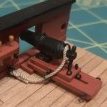
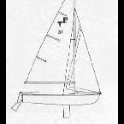
.thumb.jpeg.fc5d633a7b34428fcf19419a73d56d55.jpeg)
